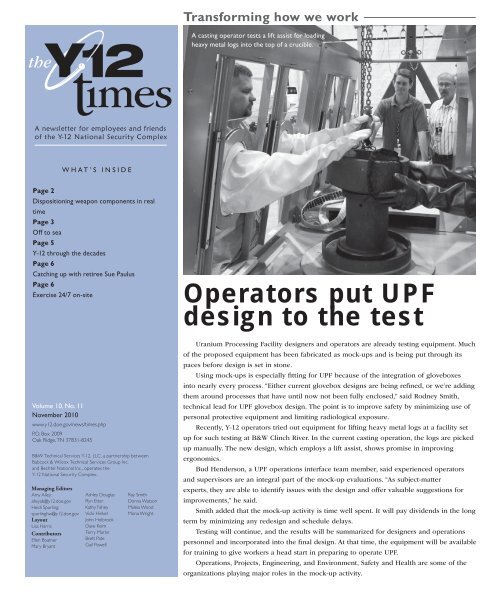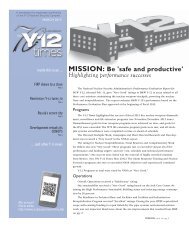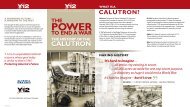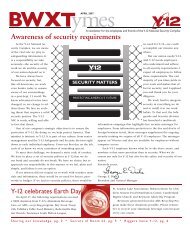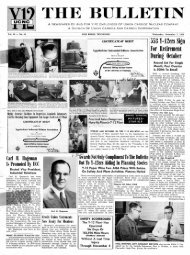November - Y-12 National Security Complex - U.S. Department of ...
November - Y-12 National Security Complex - U.S. Department of ...
November - Y-12 National Security Complex - U.S. Department of ...
You also want an ePaper? Increase the reach of your titles
YUMPU automatically turns print PDFs into web optimized ePapers that Google loves.
Transforming how we workA casting operator tests a lift assist for loadingheavy metal logs into the top <strong>of</strong> a crucible.A newsletter for employees and friends<strong>of</strong> the Y-<strong>12</strong> <strong>National</strong> <strong>Security</strong> <strong>Complex</strong>WHAT’S INSIDEPage 2Dispositioning weapon components in realtimePage 3Off to seaPage 5Y-<strong>12</strong> through the decadesPage 6Catching up with retiree Sue PaulusPage 6Exercise 24/7 on-siteVolume 10, No. 11<strong>November</strong> 2010www.y<strong>12</strong>.doe.gov/news/times.phpP.O. Box 2009Oak Ridge, TN 37831-8245B&W Technical Services Y-<strong>12</strong>, LLC, a partnership betweenBabcock & Wilcox Technical Services Group Inc.and Bechtel <strong>National</strong> Inc., operates theY-<strong>12</strong> <strong>National</strong> <strong>Security</strong> <strong>Complex</strong>.Managing EditorsAmy Alley:alleyab@y<strong>12</strong>.doe.govHeidi Spurling:spurlinghw@y<strong>12</strong>.doe.govLayoutLisa HarrisContributorsEllen BoatnerMary BryantAshley DouglasRyn EtterKathy FaheyVicki HinkelJohn HolbrookDave KeimTerry MarlarBrett PateGail PowellRay SmithDonna WatsonMaleia WoodMona WrightOperators put UPFdesign to the testUranium Processing Facility designers and operators are already testing equipment. Much<strong>of</strong> the proposed equipment has been fabricated as mock-ups and is being put through itspaces before design is set in stone.Using mock-ups is especially fitting for UPF because <strong>of</strong> the integration <strong>of</strong> gloveboxesinto nearly every process. “Either current glovebox designs are being refined, or we’re addingthem around processes that have until now not been fully enclosed,” said Rodney Smith,technical lead for UPF glovebox design. The point is to improve safety by minimizing use <strong>of</strong>personal protective equipment and limiting radiological exposure.Recently, Y-<strong>12</strong> operators tried out equipment for lifting heavy metal logs at a facility setup for such testing at B&W Clinch River. In the current casting operation, the logs are pickedup manually. The new design, which employs a lift assist, shows promise in improvingergonomics.Bud Henderson, a UPF operations interface team member, said experienced operatorsand supervisors are an integral part <strong>of</strong> the mock-up evaluations. “As subject-matterexperts, they are able to identify issues with the design and <strong>of</strong>fer valuable suggestions forimprovements,” he said.Smith added that the mock-up activity is time well spent. It will pay dividends in the longterm by minimizing any redesign and schedule delays.Testing will continue, and the results will be summarized for designers and operationspersonnel and incorporated into the final design. At that time, the equipment will be availablefor training to give workers a head start in preparing to operate UPF.Operations, Projects, Engineering, and Environment, Safety and Health are some <strong>of</strong> theorganizations playing major roles in the mock-up activity.1
Transforming how we workReal-timedispositionThe final destination <strong>of</strong> materialsgenerated from dismantlement activities canvary depending on the weapon system theycame from and activities for which they canbe used. Some materials are recycled whileothers are excessed.In the past, components were <strong>of</strong>tendismantled and stored until they could besafely dispositioned, creating a sizeablebacklog <strong>of</strong> materials.“Dispositioning weapon components isa challenge most sites face,” said a DirectedStockpile Work program manager. “At Y-<strong>12</strong>,we’ve spent the past five years reducingthe backlog <strong>of</strong> components not recycled toalmost zero and disposing <strong>of</strong> most componentsin real time.”The efforts to disposition materials inreal time have resulted in a remarkable feat.More than 250,000 cubic feet <strong>of</strong> excess materialshave been shipped <strong>of</strong>f-site, which totalsmore than 14,000 55-gallon drums.To dispose <strong>of</strong> components in realtime, most <strong>of</strong> the effort is coordinatedbefore the components are dismantled. Itrequires extensive planning to determinewhat materials will be dispositioned,the appropriate disposition path, whatcontainers will be needed for dispositionand coordination with other sites whenmaterials are sent <strong>of</strong>f-site.The significant progress made indispositioning backlogged materials couldnot have happened without the dailycommitment <strong>of</strong> personnel from many Y-<strong>12</strong>departments.Gary Ward, team leader <strong>of</strong> thegroup, said, “It’s impossible to list allthe outstanding people who assist withthis program. I cannot express howmuch I depend on their cooperation andforesightedness. We look forward to anotherproductive year in FY 2011.”Close attention to detail is required in machining samples for quality testing.Direct recycle bypasseschemical process, saves moneyY-<strong>12</strong> has completed a major innovative and cost-saving project that completelybypasses the “wet” portion <strong>of</strong> one purification process.In the old method, breaking down selected parts from the stockpile began bydissolving them to remove surface impurities and aging effects. It was a complicated,time-consuming effort.Using the new method, operators can clean the part surface by wiping and sanding.After surface cleaning, the components are moved directly to the crushing operation,eliminating nine chemical processing steps.Much work by Applied Technologies, the operations area, and technical supportand funding organizations went into verifying that the new method would meet qualitystandards. Meticulous machining was needed to prepare samples for physical testing.The tolerances challenged machine capabilities. Then changes had to be made to theprocessing equipment to handle the material without equipment breakage. As a result,new motors were purchased for the crushers and grinders.“This improvement is the first one out <strong>of</strong> the gate in the new suite <strong>of</strong> transformationtechnologies Y-<strong>12</strong> is evaluating in the effort to get better and smaller,” said Bernard Phifer<strong>of</strong> Manufacturing.The change would reduce total manufacturing process cycle time by a factor <strong>of</strong> twoand save more than $6 million per year. At this point, all purification options remain inplace. “The wet chemistry capability is not being eliminated until new technologies aredeveloped,” said Ben Davis, operations manager.The effort to replace old technologies is funded by the Stockpile ReadinessCampaign.2
Y-<strong>12</strong>ers visita sea-going air baseThirty Oak Ridge employees recently visited the Navy’s newest aircraftcarrier, the USS George H.W. Bush. Commissioned in 2009, through its seatrials and now preparing for its first deployment, this maritime giant useshighly enriched uranium to power the two on-board nuclear reactors.Supplying nuclear material to the Naval Reactors Program is one <strong>of</strong>Y-<strong>12</strong>’s four core missions. Many Y-<strong>12</strong> organizations have a hand in supplyingfeedstock for Naval Propulsion, and representatives from these groups andthe Y-<strong>12</strong> Site Office made the trip to Naval Station Norfolk in Virginia, theworld’s largest Navy base, to see the Bush carrier.Reactors provide steam for propulsion, catapult operations and electricpower generation for this sea-going city that provides military protection, aforward presence in the world’s oceans, humanitarian assistance, deterrence,sea control and maritime security. “The carrier is magnificent—nearly as longas the Empire State Building is tall,” said Y-<strong>12</strong>’s Gary Person, Naval ReactorsProgram Manager. While visiting Y-<strong>12</strong>, Admiral Kirkland H. Donald, director<strong>of</strong> Naval Nuclear Propulsion and deputy administrator <strong>of</strong> the <strong>National</strong>Nuclear <strong>Security</strong> Administration’s Naval Reactors Program, extended theinvitation for an aircraft carrier visit, and Person followed up on the rareopportunity.“Being on the carrier certainly gave us a renewed sense <strong>of</strong> purpose.Seeing the people who rely on the fuel supply brought a new dimensionto our work,” said Person. Y-<strong>12</strong> has had a working relationship with NavalReactors for more than a decade.Lt. Mike Boswell (U.S. Navy) fields a question from Mike Glasman on the bridge<strong>of</strong> the USS George H.W. Bush aircraft carrier. Left to right: Jeff Cravens (Y-<strong>12</strong> SiteOffice), Gary Person (Y-<strong>12</strong>), Glasman (Y-<strong>12</strong> Site Office), Boswell and Mike Boles(Y-<strong>12</strong>).Partnership produces dispersion modelsSafety Analysis Engineering has received the first modelingdeliverable from Y-<strong>12</strong>’s partnership with the SimCenter (<strong>National</strong>Center for Computational Engineering) at The University <strong>of</strong>Tennessee–Chattanooga.The agreement allows Y-<strong>12</strong> to take advantage <strong>of</strong> excellentsupercomputing support and to encourage further expansion <strong>of</strong> theSimCenter’s capabilities. Since the SAE group is familiar with advancedsimulations, such as Monte Carlo simulations for nuclear criticalitysafety evaluations, the group was a logical choice to spearheaddevelopment <strong>of</strong> the agreement.“We’re starting <strong>of</strong>f this collaborative effort with some plumedispersion models,” said Doug Clark <strong>of</strong> SAE. “UTC has a lot <strong>of</strong>experience creating computer simulations in areas like fluid dynamicsand thermodynamics, and Y-<strong>12</strong> hopes to help expand the center’scapabilities in the modeling <strong>of</strong> chemical reactions.”The 3D computer model UTC prepared shows how airbornereleases at Y-<strong>12</strong> might disperse. Because it includes realisticinteractions with the terrain and buildings, it will serve as acomparison with Y-<strong>12</strong>’s dispersion model, which is based on veryconservative controls. “We expect the UTC model will demonstrate justhow conservative our nuclear safety calculations are,” said Clark.The five-year basic ordering agreement with UTC was signed inMarch 2010, and the kinks were ironed out for the SAE project. Thosekinks included issues like complying with Y-<strong>12</strong>’s s<strong>of</strong>tware qualityassurance and information security requirements and protecting UTCproprietary information. To ensure compliance with s<strong>of</strong>tware qualityassurance, the agreement addresses each Y-<strong>12</strong> requirement separately.SAE is considering future work with the SimCenter. “This type <strong>of</strong>collaboration could be a powerful vehicle for other Y-<strong>12</strong> projects aslong as people aren’t afraid to try it and let go <strong>of</strong> some day-to-dayoversight,” said Clark. For an average complexity project, he estimatedthe cost at around $50,000, which is about a year’s cost <strong>of</strong> a graduatestudent with nominal faculty oversight.Reid Kress <strong>of</strong> Y-<strong>12</strong>’s <strong>National</strong> <strong>Security</strong> Technology Center is avisiting pr<strong>of</strong>essor at UTC and serves as liaison for the project, which isfunded by Plant Directed Research, Development, and Demonstration.3
Now-or-never trip to Watts Bar plantBruce Wilson, Y-<strong>12</strong> facility safety engineer, escorted newlyhired employees Kimberly Allred, Megan Deising, MichaelMacDonald and Brittany Wright on a tour <strong>of</strong> the Watts Bar Unit 2nuclear power plant in late August.It was a once-in-a-lifetime opportunity for the facility safetyengineers and fire protection engineer to see close up the safetyfeatures <strong>of</strong> the 99 percent complete facility.“If the unit had been operating, high radioactivity levelswould have prevented us from getting into many <strong>of</strong> the areas,”Wilson said.The group was fortunate to have former Y-<strong>12</strong> Facility SafetyEngineering employee Dennis Myers as a guide. Now theconstruction quality assurance manager for Unit 2, Myers wasthe perfect person to point out similarities and differences in therequirements for building and operating a commercial nuclearpower plant and a nuclear production facility.All the new hires were impressed with the magnitude <strong>of</strong> thefacility. “The scale was definitely impressive,” said MacDonald,“not just the physical size but also the defense-in-depth layers <strong>of</strong> From left, Kimberly Allred, Megan Deising, Brittany Wright, Michael MacDonald and Dennissafety.”Myers in a containment area at Watts Bar nuclear power plant.An important take-away for Deising was the importance<strong>of</strong> accurate, detailed drawings. “Watts Bar must do walk-downs <strong>of</strong> the containment—really more like crawl-arounds through the tight spaces,”she said, “and they must record each item, including the nuts and bolts, on engineering drawings. Now I understand better the magnitude andimportance <strong>of</strong> having these items accurately recorded on many designed systems at Y-<strong>12</strong>.”Wilson said the visit also emphasized that working at nuclear facilities is not just for nuclear engineers. “At the Tennessee Valley Authority, aswell as at Y-<strong>12</strong>, different types <strong>of</strong> engineers are needed for essential system and engineering safety work,” he said.The knowledge and perspective the engineers gained from their firsthand experience at Watts Bar will be put to immediate use as theyintegrate into nuclear safety work at Y-<strong>12</strong>.Schaaff named first Y-<strong>12</strong> Technology FellowThe Y-<strong>12</strong> <strong>National</strong> <strong>Security</strong> <strong>Complex</strong> recently named T. Gregory Schaaff as its first TechnologyFellow. Schaaff’s selection follows a five-month competition, which required each Y-<strong>12</strong> candidateto submit an extensive proposal, including budget and schedule, and a final competitivepresentation.The Technology Fellowship was established to give Y-<strong>12</strong> scientists and engineers the opportunityand budget to work on a two-year project <strong>of</strong> their choosing, one that would advancetechnology and science at Y-<strong>12</strong>, as well as advancing Y-<strong>12</strong>’s reputation in the chosen field. “Thefellowship is a response to our understanding that, as we work to transform the face <strong>of</strong> Y-<strong>12</strong>,we also have to work to transform how we develop and apply technologies,” said Kevin Finney,deputy manager, Program Management and Business Development.Schaaff will use his two-year fellowship to work on nonproliferation programs related tonuclear forensics, using Y-<strong>12</strong>’s technical expertise in uranium and uranium processing to advancescience in the field. He will rotate from his current position as group leader <strong>of</strong> advancedtechnologies for impurity analyses in the Analytical Chemistry Organization.Schaaff earned his Ph.D. in physical chemistry from Georgia Institute <strong>of</strong> Technology. Hiswork over the past 15 years has been concentrated in gas-phase chemistry, nanometer-scalephenomena, plasma-based analytical techniques and nuclear forensics. He is the author or coauthor<strong>of</strong> more than 30 papers in his field.4Dr. T. Gregory Schaaff, Y-<strong>12</strong>’s first Technology Fellow,will expand Y-<strong>12</strong>’s nuclear forensics capabilities.
The Y-<strong>12</strong> Times and Y-<strong>12</strong> historian Ray Smith invite you to reflect on Y-<strong>12</strong>’shistory and accomplishments. In an attempt to share the overall significance <strong>of</strong> Y-<strong>12</strong>’scontributions to the medical isotope program, the Apollo Space Program and othernuclear security accomplishments, the “Y-<strong>12</strong> through the decades” series will highlightY-<strong>12</strong>’s rich heritage. We begin with the 1940s.You’d expect that the first decade would feature the Manhattan Project years.This topic is commonly known and appreciated by Y-<strong>12</strong> employees, families and thecommunity. Y-<strong>12</strong>’s role in the historic and world-changing era <strong>of</strong> the early to mid-1940s was exceptional. The Y-<strong>12</strong> History Center has brought this era to life for visitorsto the New Hope Center.However, Y-<strong>12</strong>’s heritage is not limited to its Manhattan Project history. Did youknow, according to legend, the location for Y-<strong>12</strong> was selected by Sen. Ken McKellarwhen he responded to President Roosevelt’s request to keep secret the use <strong>of</strong> fundsnecessary for the Manhattan Project. McKellar is said to have responded, “Yes, Mr.President, I can do that for you. Just where in Tennessee are you going to put that‘thang?’”You likely know the rest: Y-<strong>12</strong> was built as one <strong>of</strong> the primary Manhattan Projectplants to separate uranium-235 from natural uranium for the first atomic bomb, LittleBoy (pictured at right, second from top). This first mission saw 22,482 employees onthe payroll on Aug. 21, 1945, which is still the highest number <strong>of</strong> employees ever towork at Y-<strong>12</strong> at one time.The 1,152 calutrons (pictured bottom right) used to separate the uranium-235were installed in nine major buildings, still standing today. Two <strong>of</strong> these earlystructures have been earmarked for historic preservation.Building 9731, constructed in March 1943, is the first building completed at Y-<strong>12</strong>.It houses the sole remaining alpha calutron magnets in the world. This structure isbeing restored and was opened to the public for the first time in June 2010 duringOak Ridge’s Secret City Festival.Building 9204-3 (Beta 3), the only one <strong>of</strong> the nine major buildings to continue tohouse calutrons and which operated those calutrons until 1998, was opened to thepublic in 2005. We hope to allow access again soon.Next month, learn about Y-<strong>12</strong>’s significant accomplishments beyond theManhattan Project and into the 1950s.5
The cabin on the creekSue and TJ Paulus at their cabin on CokerCreek. While the Paulus family enjoys resting,gardening and getaways at their “new”modified A-frame, its main purpose is vacationrental, and Sue manages the online marketingherself.Many people shy away from the stress <strong>of</strong> even a small homeremodeling project. Not Y-<strong>12</strong> retiree Sue Paulus. She isn’t fazedby lifting a house completely <strong>of</strong>f its foundation. The electricaldesign engineer/manager, who retired from Engineering in2004, knows to take a project step by step.The work began after she and husband TJ fell in lovewith and bought a cabin on Coker Creek about 10 milessouth <strong>of</strong> Tellico Plains. The fact that it needed major repairsand had been flooded a few years back just presented moreopportunities.First she determined that the flood waters had risen theheight <strong>of</strong> about four cinder blocks. “We figured raising the cabinfour feet would prevent flooding in the future,” she said. So shecalmly started asking around, “Do you know a house mover?”Then she called in a mold-elimination expert, whorecommended a cleaning solution and adding a fan and someblack lights in the crawl space. After that, it was on to the funpart <strong>of</strong> “visualizing the new kitchen and bathrooms.”Looking back to the remodeling, she said it was a great way <strong>of</strong> getting to know people inthe area. “Searching out craftspeople and encouraging local artisans was very rewarding,” shesaid. “From the stone fireplace to the gazebo <strong>of</strong>f the deck to the wrought-iron stair railing, weappreciate them as pieces <strong>of</strong> art.”What about the cost <strong>of</strong> jacking up the cabin and laying a new foundation? “It turned out tobe quite reasonable,” she laughed.All LIFE Centers up and running 24/76Front row from left, Jeff Underwood (Y-<strong>12</strong>Site Office deputy manager), Travis Baker(Production), Chris Carr (Production) andBill Klemm (President’s Office) cut theribbon at the opening <strong>of</strong> the third LIFECenter.Gone are the days when you would say you didn’texercise because the gym was closed. “It’s important toour people that we’ve got a great program with threeLIFE (Lifestyle Intervention For Employees) Centersopen 24/7,” President and General Manager DarrelKohlhorst said at the opening <strong>of</strong> the West LIFE Center,the last <strong>of</strong> three on-site fitness centers to open.“I never thought I would see something like this atY-<strong>12</strong>,” said Production’s Travis Baker when referring tothe West LIFE Center that opened Sept. 20.“I think the equipment is great,” Baker said. “It’snicer than where I normally work out, and it’s greatthat it’s so convenient to a changehouse.”Employees are encouraged to find the LIFE Centerclosest to them and check it out. If your badge hasn’tbeen activated for the LIFE Centers, you will need tostop by the LIFE Center in the Jack Case Center.“I plan to use the center as my schedule allows,”said Chris Carr, also in Production. “In the winter, it will be handy to have access to a treadmillthat I can use to run on.”As wellness coordinator Levette Harris-Bethea said at the ribbon-cutting event, “Missionaccomplished.” Now it’s up to employees to put the LIFE Centers to use.
Around Y-<strong>12</strong> ...• Y-<strong>12</strong>’s Sustainability and Stewardship Program received the Tennessee Chamber<strong>of</strong> Commerce and Industry 2010 Environmental Excellence Award. The programwas recognized Oct. 13, at a ceremony in Nashville, for “Y-<strong>12</strong>’s Sustainability andStewardship Program Transforms Y-<strong>12</strong> into a Greener and Leaner <strong>Complex</strong>.”• The <strong>National</strong> Nuclear <strong>Security</strong> Administration announced Sept. 30 that it has awardedB&W Y-<strong>12</strong> a one-year extension <strong>of</strong> the management and operations contract at Y-<strong>12</strong>,with two three-month options. The one-year extension runs from Oct. 1, 2010, throughSept. 30, 2011. “We’re extremely pleased that NNSA has extended our contract. Webelieve the extension recognizes strong past performance and shows confidence in ourability to continue operating the site safely, effectively and efficiently,” said B&W Y-<strong>12</strong>President and General Manager Darrel Kohlhorst.• Darlene Lasley <strong>of</strong> Industrial Hygiene received a Champion <strong>of</strong> Excellence Award fromthe Alliance <strong>of</strong> Hazardous Materials Pr<strong>of</strong>essionals. The Alliance <strong>of</strong> Hazardous MaterialsPr<strong>of</strong>essionals has a membership <strong>of</strong> more than 4,000 <strong>of</strong> the nation’s leading experts inenvironmental, health, safety and security management.• Y-<strong>12</strong> launched four <strong>of</strong> its own social media sites—Facebook, Flickr, Twitter andYouTube. Secretary <strong>of</strong> Energy Steven Chu launched U.S. <strong>Department</strong> <strong>of</strong> Energy socialmedia sites and has encouraged other DOE sites to establish their own social mediaoutlets. Y-<strong>12</strong>’s social media sites are in response to the Secretary’s lead and NNSA’sexpectations. Stay tuned to YSource for more information.• Open enrollment for 2011 benefits elections continues through 4 p.m. Nov. 16.During this time, employees have the opportunity to (1) enroll in either the dental ormedical plans, if not a current participant; (2) choose between the two CIGNA Medicaloptions (Open Access or Point <strong>of</strong> Service) and dental providers (Delta or MetLife);(3) change pre/post tax election for dental/medical; (4) add or delete dependents fordental/medical and (5) enroll in a Dependent Care or Healthcare Spending Account.(Remember that you must make Dependent Care or Healthcare Spending Accountelections each year. They do not automatically continue from year to year.) The changeswill be effective Jan. 1, 2011.In memoriamGlen “Mac” McCrary, a weldinginspector in Programs andQuality, passed away Sept. 23. Hehad 33 years <strong>of</strong> company service.“Everyone not only in the weldinginspectors group but also in thewelding group had great respect forMac. He covered our work efficientlyand made friends with all whowere involved. He was extremelyknowledgeable about our craft,” saidco-worker Leisa Pittman.“Glen was a hard worker and awell-respected leader. He was alwaysthere to help anyone and everyone inany possible way,” said Joshua Porter,another co-worker.In memoriamLarry Monroe <strong>of</strong> PerformanceAssurance passed away Oct. 4. Hehad two years <strong>of</strong> company service.“When I think <strong>of</strong> Larry, Iremember his kind, sweet spirit,”said Eugene Harmon. “He always hadgreat outlook on life, and even whenhe was so sick, he still continuedto bring joy to those around him. Ihave lost not only a very competentand loyal co-worker but also a trueChristian friend.”Co-worker Charlesetta Lathamsaid, “Larry was an honest man whowas loved and respected by many. Hetouched the lives <strong>of</strong> everyone aroundhim.”NOVEMBER42 yearsEngineering: Glenn R. BridgesProduction: Wayne Gibson41 yearsProduction: Timothy R. Hill Sr.40 yearsEngineering: Morgan DefenderferFacilities, Infrastructure and Services: Norman L. SmithProduction: Cas V. Cox and Stephen R. McCartyTechnical Integration: Larry W. Johnson35 yearsBusiness Services: Gene C. Davy and William S. KiserEnvironment, Safety and Health: Donna M. StokesFacilities, Infrastructure and Services: Jacquita D.WilsonOccupational Health Services: Patsy M. SheltonProduction: Kathlene Beatty30 yearsEmergency Services: Michael H. Isaacson andCheryl M. WomackEnvironment, Safety and Health: Bruce W. ValentineFacilities, Infrastructure and Services: Ronald D.Grant, Michael D. McCormack, Stanley T. Smith,Bennie E. Williams and James N. WyattProduction: Robert G. GrahamPrograms and Quality: Robert B. Bonner andDeborah A. BrockProgram Management: Terryann Nelson25 yearsBusiness Services: John W. Goan Jr. andWillie L. HenleyEngineering: Frank J. SweeneyEnvironment, Safety and Health: Samuel F. LarivierePrograms and Quality: Mary L. Moore20 yearsBusiness Services: Linda K. ShawChief Financial Officer Division: V. Robert Defenderferand John C. StraderEngineering: James J. YugoEnvironment, Safety and Health: Rebecca W. OwnbyPerformance Assurance and Productivity: Amy P.DuncanProjects: Melissa L. BlairBe an angel this holiday season.Volunteer for the Y-<strong>12</strong> Employees’Society Angel Tree committee.Contact Lisa Harris (576-2658) formore information.7
Y-<strong>12</strong> Employees’Society Holiday PartiesDec. 16, employees’ party4 to 6:30 p.m.Jack Case Center cafeteriaDec. 18, children’s party2 to 6 p.m.New Hope CenterContacts: Lisa Harris, 576-2658or Rashaun Williams, 241-4210P.O. Box 2009Oak Ridge, TN 37831-8245PRSRTSTDPAIDU. S. PostagePermit #36Powell, TNCraftspeople: They‘make it happen’Ironworker Bill Aikens, likemany Y-<strong>12</strong> craftspeople, helpsget things done.Although Y-<strong>12</strong> craftspeople have the skill to help keep things in working order,many are <strong>of</strong>ten called on to assist with new inventions as well.After working in construction for 10 years, at Y-<strong>12</strong> for nearly 30 and on personalprojects at home, ironworker Bill Aikens has the ability to spot complications early.“I may see something they don’t see,” Aikens said. “Someone comes in with anidea <strong>of</strong> what they need and says, ‘Bill, figure this out,’ and I can normally come upwith something to solve it,” he continued, laughing.Patrick Thomas, a security specialist who recently received much attention forhis invention <strong>of</strong> a fish-hook lock for roll-up-doors, worked with many specializedcraftspeople during its initial development.“I didn’t do anything; I drew a sketch,” Thomas said. “These people and mymanagement helped me with every step <strong>of</strong> the process. They deserve the credit.”According to Thomas, if it weren’t for the craftspeople here at Y-<strong>12</strong>, his ideawould have stayed on paper. “They just make it happen,” he said.For a single project, there may be any number <strong>of</strong> welders, painters, locksmithsand carpenters involved. With such a team dynamic, most projects last from a fewhours to a week.“It takes a lot <strong>of</strong> people to get a job done,” said Larry West, supervisor forironworkers and riggers.Aikens added there are many changes throughout the process. “There are a lot<strong>of</strong> back-and-forth conversations,” he said. “We look at a project and see what wecan do to make it lighter, stronger and easier to use. Sometimes the finished projectdoesn’t even look like it [did when we] started out.”


